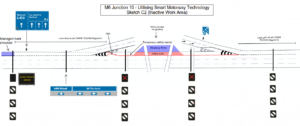
The M6 J10 scheme requires two bridges to be replaced as part of the overall junction capacity improvement. Traditional traffic management in accordance with Chapter 8 of the Traffic Signs Manual would normally be utilised with a permanent 50mph speed limit to reduce the risk to the travelling public and workforce within the work areas. This often leads to road user frustration and dis-satisfaction as they often see no works ongoing and do not understand why there is a reduced speed limit.
Constructing the new bridges would take around 18 months and Highways England wanted as little disruption as possible but had accepted that the current four lanes in each direction could be reduced to three with narrow lanes and a 50mph speed restriction. This would be delivered utilising Chapter 8 traffic management (temporary cones and signs).
John Bowes had chaired and participated in two challenge workshops with the design team. During this he gained an understanding of the existing smart motorway layout along this section of the M6 and the works required to construct the bridges. Traditional traffic management had been assumed by the design team and that this would remain in place during the bridge construction works. The challenge with this approach is that the travelling public would be frustrated as there will be periods of up to 16 weeks where no work will be undertaken adjacent to the carriageway.
John had the innovative idea to use the smart motorway technology to provide a variable speed restriction through the junction with negligible temporary traffic cones and signs. The two schematics above show the northbound carriageway, the work areas and the site entry and exits. Also shown is a lane drop through the junction which provides a safety zone to the work area and provides a safer approach to the junction for traffic leaving the motorway as it removes all weaving manoeuvres.
The proposal was developed and initially discussed with key Highways England stakeholders including the Traffic Officer lead for the area where it gained full support.
In summary the option offers the following benefits:
The solution was developed further accounting for stakeholder comments and a safety risk assessment undertaken which demonstrated an improvement over traditional traffic management. The solution was shared with the contractors tendering the scheme and the approach has been adopted by the successful contractor (Sisk).